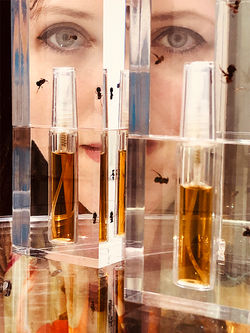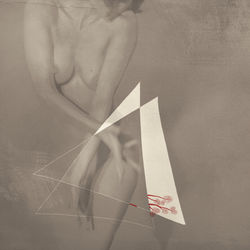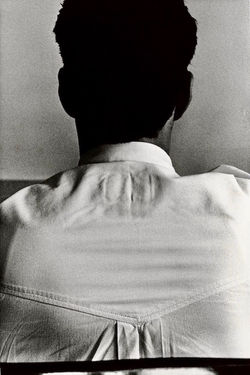
Feminine / Masculine
A curated international photography exhibition
February 11 – March 6, 2021 newsletter
 |  |
|---|---|
 |  |
 |  |
 |  |
 |  |
 |  |
 |  |
 |  |
 |  |
 |  |
 | ![Virtual - Projecting nude on nude [2.]](https://static.wixstatic.com/media/1a9477_3b4a47efac864d9a80eb1ad426d14f00~mv2.jpg/v1/fill/w_250,h_185,al_c,q_90,enc_auto/1a9477_3b4a47efac864d9a80eb1ad426d14f00~mv2.jpg) |
![Projecting layers [1.]](https://static.wixstatic.com/media/1a9477_b72286467abf4e3ba7fa6f4bbdd0b83c~mv2.jpg/v1/fill/w_250,h_350,al_c,q_90,enc_auto/1a9477_b72286467abf4e3ba7fa6f4bbdd0b83c~mv2.jpg) |  |
 |  |
 |  |
 |  |
 |  |
 |  |
 |  |
 |  |
 |  |
 |  |
 |  |
 |  |
 |  |
 |  |
 |  |
 |  |
 |  |
 |  |
 |  |
 |  |
 |  |
 |  |
 |
Click on the thumbnail to view the image. Click on the image for a larger view and information.
Portrayals of femininity and masculinity are, without doubt, central to a number of art forms, photography not being an exception. The past few decades have given rise to – often heated – discussions and criticisms of past, recent, and current photographic practices for their lack of reflection on the assumptions, stereotypes, and prejudices surrounding photographic approaches to femininity and masculinity. Fine art and commercial works alike have been critiqued for the potential consequences of their approach and presentation. Historically femininity and masculinity have been conceived, among others, as oppositions, as complements of each other, or as positions on a continuum. There are hardly any ways of portraying femininity and masculinity that would or could not be considered trivial, conservative, pretentious, demeaning, distasteful, clichéd or even offensive by some. It often seems that everything has been both said and photographed about this subject, and yet, it is not possible to ignore the persistence of the theme in our contemporary visual culture. What is it that we can still value and possibly revive from the rich history of photography; are there any novel ways left to approach this subject with a fresh critical eye?
Curator's choice
Isolated Lovers, 2020—Waiting, Her Story #4
Isolated Lovers, 2020—Waiting, His Story #2
Honourable mentions
Joan Haseltine: Running from the Past, from the series 'The Girl Who Escaped and Other Stories'
Berta Ibáñez: Dismantling #3
Juta Jazz: Opus 9
Exhibiting photographers
Mildred Alpern (New York, NY, USA), Fruzsina Augusztinyi (Budapest, Hungary), Jeremy Bach (Canandaigua, NY, USA), Dwayne Bryk (Montreal, QC, Canada), Catherine Caddigan (Randolph, MA, USA), Paul Delpani (Vienna, Austria), Suzette Dushi (New York, NY, USA), Christopher Fluder (New York, NY, USA), Sean Freeman (Cumming, GA, USA), Sari Fried-Fiori (Katy, TX, USA), László Gálos (Salgótarján, Hungary), Nadide Goksun (WhitePlains, NY, USA), Joan Haseltine (Big Timber, MT, USA), Daniel Hill (Vienna, Austria), Michael Honegger (Nice, France), Bruce G. Hooke (Plainfield, MA, USA), Éva Horvát (Budapest, Hungary), Berta Ibáñez (Foix, France), Juta Jazz (Nicosia, Cyprus), Robert S Johnson (New York, NY, USA), Elizabeth Kayl (Loveland, CO, USA), Michael Kelly-DeWitt (Sacramento, CA, USA), Paul Kessel (New York, NY, USA), Tomas Lagūnavičius (Kaunas, Lithuania), Heather Joy Layton (Huntington Beach, CA, USA), Joe LeGrand (St. Petersburg, FL, USA), Michelle Luke (Kalispell, MT, USA), Yoshitaka Masuda (Tokyo, Japan), Rose Materdomini (New York, NY, USA), Satoko Nishioka (Tokyo, Japan), Juergen Pawlik (Woerthsee, Germany), András Polgár (Budapest, Hungary), Parker James Reinecker (Salisbury, NC, USA), Russ Rowland (New York, NY, USA), Angus Stewart (London, UK), Eiji Yamamoto (Saarbruecken, Germany)
Please click on the names to see contact information (website or e-mail) where available.
Feminine/Masculine
Borbála Jász
The exhibition Feminine/Masculine at the PH21 Gallery presented a selection of photographs on a topic that has always inspired artists. As the gender issue has become an important part of social discourse lately, many artists have taken inspiration from the subject. From street photography to portraiture to narrative photography, the theme of femininity and masculinity can appear in all photographic genres.
In Michelle Luke’s pair of pictures, Isolated Lovers, 2020—Waiting, Her Story #4 and His Story #2, we are confronted from a male and female perspective with an expectation that will be familiar to many of us when wondering: will the other person show up for our date? The sense of possibility of an encounter is surely intensified during the pandemic, and not merely for longing lovers. The persons experiencing these elemental emotions are portrayed from above, an interesting perspective in the images. In both cases, our attention is immersed in the texture of the hair, while all other parts are blurred. The faces are not visible; any one of us could be these characters. Colours do not distract us from the uncertainty manifested in the process of waiting. In the structure of the images, the artist shows this tension with a partially closed, diagonal composition. The fine distribution of the proportions of sharpness and blur results in harmonious photographs.
Joan Haseltine’s photograph Running from the Past evokes the world of the 1950s and ’60s in a cinematic form. The photographer’s approach is the cinematic lens. In the image of the woman, the photographer finds a permanent, unchangeable component and reveals it to the viewer. In the staged narratives of the project entitled ‘The Girl Who Escaped and Other Stories’, the photographer displays classic feminine objects concretely or symbolically: the scarf, the string of pearls, the bleached hair and red lipstick. Together, these make the work of art timeless and a symbol of femininity in every age. While contemplating these attributes, we did not even think about the story of the escape yet, which the photographer leaves open.
In case of the photograph by Berta Ibáñez entitled Dismantling #3, even the subject of the image is not clear at first sight. We merely observe the fragmentation, the fragility, and the appearance of the image of the human being as a whole. Looking more closely at the picture, we realise that this is not a real man, but a puppet. The image contains a double reflection, doubly confronted with the uncertainty of our existence: firstly, with the fragmentation, and secondly, with the revelation of the presence of the puppet created in the image of man. The use of complementary colours balances the composition of the image, reinforcing the tension between form and content.
Juta Jazz’s photograph Opus 9 shows a similar picture, as two mirrors facing each other. In fact, we arrive at a specific moment in the endless story of the woman. The observer is faced with a realistic, figural and – geometrically – abstract pictorial formulation of a woman. In addition to the spatial extension of the timeline, the image reveals the harmony between masculine and feminine forces. The organic, rounded, ‘feminine’ forms are balanced by the strict, sharply edged, ‘masculine’ shape of the square into a composition that is harmonious in both content and form.
Photographs by Dushi, Fluder, Le Grand and Jazz similarly display fragility. In Dushi’s picture entitled The Dance, different levels and layers of a relationship appear in a figural and abstract way. An interesting example of an abstract and symbolic formulation of masculinity and femininity is Nishioka’s Epilogue. Both of Yamamoto’s black-and-white photographs show the femininity that appears in the figure in an almost sensual way. The images of Lagunavicius have a similar effect on the viewer, even though these images are in colour.
In some cases, stereotypical elements such as weapons (Reinecker) and stockings (Layton) can be observed in the emergence of masculinity and femininity. In other works, we can see the depths of the gender issue and the related, specific situations experienced in unique cases, such as in the pictures of Éva Horváth and Daniel Hill. The balancing of male and female power and the compliance with social roles are symbolised by photographs depicting dance.
In this selection, we may observe the various shapes of femininity and masculinity. The approaches are as diverse as our thoughts about femininity and masculinity, but the images all bring us closer to developing a deeper sensibility and understanding of the theme.